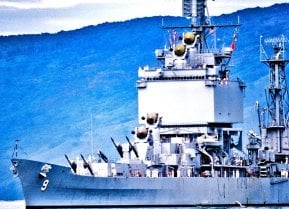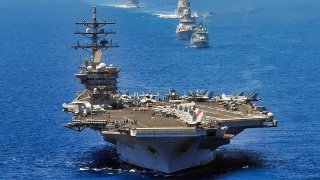Think the Age of the Aircraft Carrier Is Over Thanks to Missiles? Not Exactly.
The U.S. Navy has taken extensive measures to protect its carriers, including constant movement, electronic warfare systems, and surface-to-air missiles.
Summary: The U.S. Navy has taken extensive measures to protect its carriers, including constant movement, electronic warfare systems, and surface-to-air missiles. A recent software update on Arleigh Burke-class destroyers and the successful interception of a Houthi missile by the USS Gravely's Phalanx CIWS underline the Navy's defensive capabilities. Despite the challenges, U.S. Navy personnel continue to safeguard their carriers against the increasing missile and drone threats in conflict zones.
Carrier Killer? Good luck – The U.S. Navy Aircraft Carriers Can Fend Off a Missile Attack
On Saturday, a Chinese-owned oil tanker was hit by a Houthi missile while transiting the Red Sea. The Panamanian-flagged, Chinese-owned and operated Huang Pu was targeted after previous warnings from the Iranian-back group that it would not attack Chinese vessels. The extent of the damage isn't known, but the vessel reported that there were no casualities.
The Houthi rebels currently control much of Yemen's Red Sea coast and have launched dozens of missile and drone strikes on shipping over the past month – claiming they are acting in solidarity with the Palestinians in Gaza. In addition to targeting commercial vessels, the Iran-back rebel group has also fired missiles at U.S. warships. To date, no U.S. warship has been struck.
Of course, the Houthis likely have quite a big target in their sights, namely the Nimitz-class nuclear-powered aircraft carrier USS Dwight D. Eisenhower (CVN-69). The warship is reportedly engaged in fire levels compared to World War II battles.
A question commonly asked prior to the carrier strike group's (CSG's) arrival in the Red Sea on November 4, was how a supercarrier could defend itself from a missile attack. This is no longer really a hypothetical. While it isn't known if any drones or missiles specifically targeted the carrier, U.S. warships have been in the crosshairs almost daily.
The U.S. Navy has responded accordingly.
Though many weapons have been touted as "carrier killers," the truth is that a carrier is actually a well-protected warship, especially when it is operating in the open ocean. Though not exactly fast compared to aircraft, the carrier is typically always on the move, and that is a key part of its defenses – you can't hit a target if you don't know where it is. And even if a warship's location is determined, it will have moved on by the time the missile reaches the target.
Ring of Counter-Fire for U.S. Navy Aircraft Carriers
Aircraft carriers are also netted with friendly assets that create a ring upwards of hundreds of miles from the vessel.
This screen is meant to ensure that an adversary's aircraft, surface vessels, or submarines can't even think about getting close to the carrier. The carrier and its strike group are also equipped with electronic warfare systems for deceiving the sensors and disrupting the command links of incoming threats. At the same time, the guide-missile destroyers are armed with a variety of surface-to-air missiles designed to counter anti-ship missiles, including the types employed by the Houthis.
The problem is compounded when a flattop operates in littoral waters such as the Red Sea. Yet, most incoming aerial threats from missiles and drones are being targeted dozens of miles out or even further.
To ensure that the CSG retains its advantage, last week, the United States Navy and Lockheed Martin announced that a software update was installed on its Arleigh Burke-class guided-missile destroyers that have been operating in the region since last fall.
And if a threat does get through, there are other defensive systems in place.
On January 30, 2024, a Houthi anti-ship cruise missile came within a mile of the United States Navy's Arleigh Burke-class destroyer USS Gravely (DDG-107) – mere seconds from striking the warship. Fortunately, the Phalanx Close-in Weapon System (CIWS) was able to destroy the missile in flight. It marked the first use in the ongoing conflict of the system that has been rightfully described as the U.S. Navy's "last line of defense."
Striking a carrier with a missile isn't impossible, yet it would be challenging. Even then, a single missile wouldn't sink it. Carriers are designed to take significant damage and remain operational.
Finally, the U.S. Navy's sailors are among the best in the world at their jobs, and they are on the most advanced warships in the world. They'll continue to ensure that no missile, drone, or other threat gets anywhere close to the carrier.
Author Experience and Expertise: Peter Suciu
Peter Suciu is a Michigan-based writer. He has contributed to more than four dozen magazines, newspapers, and websites with over 3,200 published pieces over a twenty-year career in journalism. He regularly writes about military hardware, firearms history, cybersecurity, politics, and international affairs. Peter is also a Contributing Writer for Forbes and Clearance Jobs. You can follow him on Twitter: @PeterSuciu. You can email the author: [email protected].


